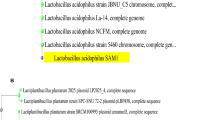Abstract
Lactobacilli are considered to be one of the most important potential probiotics in the dairy industry. Twelve strains of Lactobacillus were isolated from home-made koumiss samples, a traditionally fermented mare milk in China. The isolates were identified based on physiological and biochemical characteristics and analysis of 16S RNA sequences. They were proven to be Lactobacillus helveticus, Lactobacillus fermentum, Lactobacillus casei and Lactobacillus plantarum. The results demonstrated that both methods were essential to identify an isolate accurately.


Similar content being viewed by others
References
Adnan AFM, Tan IKP (2007) Isolation of lactic acid bacteria from Malaysian foods and assessment of the isolated for industrial potential. Bioresour Technol 98(7):1380–1385
Atrih A, Rekhif N, Moir AJG et al (2001) Mode of action, purification and amino acid sequence of plantaricin C19, an anti-Listeria bacteriocin produced by Lactobacillus plantarum C19. Int J Food Microbiol 68:93–104
Badis A, Guetarni D, Moussa-Boudjemâa B et al (2004) Identification of cultivable lactic acid bacteria isolated from Algerian raw goat’s milk and evaluation of their technological properties. Food Microbiol 21(3):343–349
Bergey DH, Harrison FC, Breed RS et al (1923) Bergey’s manual of determinative bacteriology, 1st edn edn. Williams and Wilkins, Baltimore, p 184
Berthier F, Ehrlich SD (1998) Rapid species identification within two groups of closely related lactobacilli using PCR primers that target the 16S/23S rRNA spacer region. FEMS Microbiol Lett 161:97–106
Broberg A, Jacobsson K, Ström K et al (2007) Metabolite profiles of lactic acid bacteria in grass silage. Appl Environ Microbiol 73(17):5547–5552
De Vuyst L, Leroy F (2007) Bacteriocins from lactic acid bacteria: production, purification, and food Applications. J Mol Microbiol Biotechnol 13(4):194–199
Fujisawa T, Benno Y, Yaeshima T et al (1992) Taxonomic study of the Lactobacillus acidophilus group, with recognition of Lactobacillus gallinarum sp. nov. and Lactobacillus johnsonii sp. nov. and synonymy of Lactobacillus acidophilus group A3 with the type strain of Lactobacillus amylovorus. Int J Syst Bacteriol 42:487–491
Gutmann I, Wahlefeld AW (1974) L(+) lactate: determination with lactic dehydrogenase and NAD. In: Bergemeyer HU (ed) Methods of enzymatic analysis. Academic Press , New York, pp 1452–1456
Holt JG, Krieg NR, Bergey DH et al (1984) Bergey’s manual of systematic bacteriology, vol 1. Williams and Wilkins, Baltimore
Holt JG, Krieg NR, Bergey DH et al (1984) Bergey’s manual of systematic bacteriology, vol 4. Williams and Wilkins, Baltimore
Kempler GM, Mc Kay LL (1980) Improved medium for detection of citrate-fermenting Streptococcus lactis subsp diacetylactis. Appl Environ Microbiol 39:927–956
Lavermicocca P, Valerio F, Evidente A et al (2000) Purification and characterization of novel antifungal compounds by sourdough Lactobacillus plantarum 21B. Appl Environ Microbiol 66:4084–4090
Mathara JM, Schillinger U, Kutima PM et al (2004) Isolation, identification and characterization of the dominant microorganisms of kule naoto: the Maasai traditional fermented milk in Kenya. Int J Food Microbiol 94:269–278
Messens W, De Vuyst L (2002) Inhibitory substances produced by Lactobacilli isolated from sourdoughs—a review. Int J Food Microbiol 72:31–43
Michel C, Pelletier C, Boussaha M et al (2007) Diversity of lactic acid bacteria associated with fish and the fish farm environment. established by amplified rRNA gene restriction analysis 73(9):2947–2955
Montanari G, Zambonelli C, Grazia L et al (1996) Saccharomyces unisporus as the principal alcoholic fermentation microorganism of traditional koumiss. J Dairy Sci 63:327–331
Norris JR, Berkeley RCW, Logan NA et al (1981) The genera Bacillus and Sporolactobacillus. In: Starr MP, Stolp H, Trüper HG, Balows A, Schlegel HG (eds) The prokaryotes: a handbook on habitats. Isolation and identification of bacteria. Springer, Berlin, pp 1711–1742
Orla-Jensen S (1919) The lactic acid bacteria. A. F. host and Son, Koeniglicher Hofboghandel, Copenhagen
Rossello-Mora R, Amann R (2001) The species concept for prokaryotes. FEMS Microbiol Rev 25:39–67
Samelis J, Maurogenakis F, Metaxopoulos J (1994) Characterization of lactic acid bacteria isolated from naturally fermented Greek dry salami. Int J Food Microbiol 23:179–196
Scarpellini M, Mora D, Colombo S et al (2002) Development of genus/species-specific PCR analysis for identification of Carnobacterium strains. Curr Microbiol 45:24–29
Sneath PHA, Mair NS (1986) Sharpe M.E. Bergey’s manual of systematic bacteriology, vol 2. Williams & Wilkins, Baltimore, pp 1209–1245
Stiles ME, Holzapfel WH (1997) Lactic acid bacteria of foods and their current taxonomy. Int J Food Microbiol 36:1–29
Thomas TD (1973) Agar medium for differentiation of Streptococcus cremoris from the other bacteria. NZ J Dairy Sci Technol 8:70–71
Vandamme P, Pot B, Gillis M et al (1996) Polyphasic taxonomy, a consensus approach to bacterial systematics. Microbiol Rev 60:407–438
Wood BJB, Holzapfel WH (1995) The genera of lactic acid bacteria. Blackie Academic and Professional, New York, p 28
Acknowledgments
This research was supported by the Natural Science Foundation of China (Grant No.30560097, 30660135 and 30760156), Hi-tech Research and Development Program of China (863 Program) (Grant N0. 2006AA10Z345 and 2007AA10Z353) and New Century Excellent Talent (NCET) Planning of Education Ministry of China.
Author information
Authors and Affiliations
Corresponding author
Rights and permissions
About this article
Cite this article
Wang, J., Chen, X., Liu, W. et al. Identification of Lactobacillus from koumiss by conventional and molecular methods. Eur Food Res Technol 227, 1555–1561 (2008). https://doi.org/10.1007/s00217-008-0880-4
Received:
Revised:
Accepted:
Published:
Issue Date:
DOI: https://doi.org/10.1007/s00217-008-0880-4




